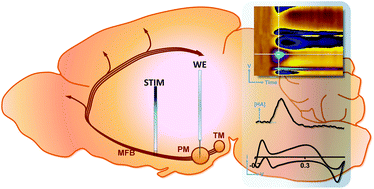In vivo histamine voltammetry in the mouse premammillary nucleus
Abstract
Histamine plays a major role in the mediation of allergic reactions such as peripheral inflammation. This classical monoamine is also a neurotransmitter involved in the central nervous system but its role in this context is poorly understood. Studying histamine neurotransmission is important due to its implications in many neurological disorders. The sensitivity, selectivity and high temporal resolution of fast scan cyclic voltammetry (FSCV) offer many advantages for studying electroactive neurotransmitters. Histamine has previously been studied with FSCV; however, the lack of a robust Faradaic electrochemical signal makes it difficult to selectively identify histamine in complex media, as found in vivo. In this work, we optimize an electrochemical waveform that provides a stimulation-locked and unique electrochemical signal towards histamine. We describe in vitro waveform optimization and a novel in vivo physiological model for stimulating histamine release in the mouse premammillary nucleus via stimulation of the medial forebrain bundle. We demonstrate that a robust signal can be used to effectively identify histamine and characterize its in vivo kinetics.

- This article is part of the themed collection: In vivo analysis

 Please wait while we load your content...
Please wait while we load your content...